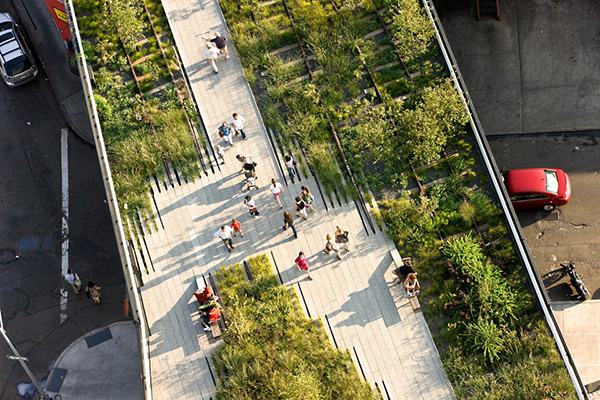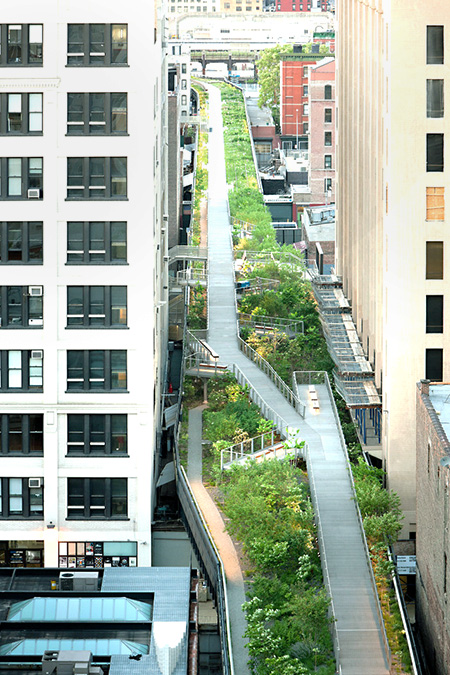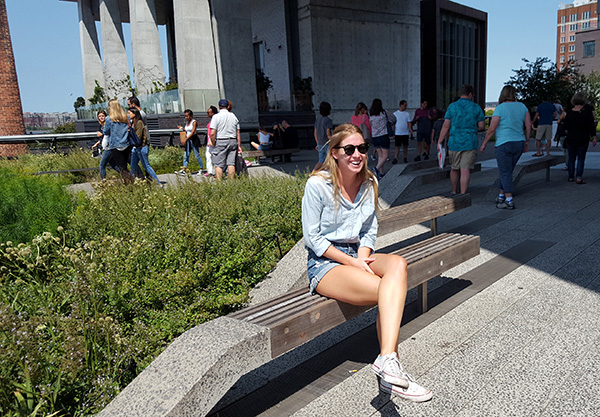 Aerial view of the High Line park in NYC, elevated 30-feet above the street and filled with greenery and unique park benches to take in the sights of the city. Source: Iwan Baan/Friends of the High Line
Aerial view of the High Line park in NYC, elevated 30-feet above the street and filled with greenery and unique park benches to take in the sights of the city. Source: Iwan Baan/Friends of the High Line
Who would ever think you could take an old abandoned rail line, add some plants and park benches, and turn the space into one of the most visited parks on the planet?
That's exactly what happened to the High Line park in NYC on Manhattan's West Side.
Here are 10 facts that make this park so unique:
- Park in the Air - It's elevated. How many parks in the world sit above the ground? You could be sitting on a park bench reading a book and there are cars driving 30 feet below.
- Train in the Air - The original elevated rail line was started in 1934 to provide a safer way to transport goods, including meat, to the warehouse district in NYC.
- Cowboys On Horseback In NYC - That's because the rail line on the ground was so dangerous on Manhattan's West Side, that it was called "Death Avenue" and cowboys on horses rode in front of the trains waving warning flags. By the way, the last train carried three carloads of frozen turkeys.
- Gardens in the Air - For a park that is in the air, 350 species of perennials, grasses, shrubs, vines and trees all thrive there.
 Park benches dot the Falcone Flyover section of The High Line linear park in NYC. Source: Iwan Baan/Friends of the High Line
Park benches dot the Falcone Flyover section of The High Line linear park in NYC. Source: Iwan Baan/Friends of the High Line - Distinctive Park Benches - The High Line park is home to a bunch of unique "peel up" park benches, where one end rises up from the ground.
- Artwork in the Sky - The park is more than a park. It's also an outdoor art museum. There are works installed there by more than 120 artists commissioned from around the world.
- Small Space - The park is just 1.45 miles long.
- Big Attraction - Yet, it draws about 5 million visitors per year. An estimated 20 million people have visited this little stretch of greenery, art, park benches, lights and several unique stopping points.
- Huge Return on Investment - What's even more interesting, experts say the High Line has been the catalyst for about $2 billion in development surrounding the park. Property values near the park have reportedly risen by 103% from 2003 to 2011. Talk about an economic development engine.
- Two Citizens Get It Started - The last train ran on the High Line in 1980. But it was the determination of two residents, Joshua David and Robert Hammond, who in 1999 formed a non-profit group called "Friends of the High Line" and advocated for the creation of the park instead of just demolishing the elevated railway as originally proposed. The dodged perseverance of the group paid off when in 2006, groundbreaking took place and in 2009 the area from Gansevoort to West 20th Street was first opened to the public.
Sit on the park benches and enjoy varied views and landscapes
What makes the High Line park even more incredible, is that even for this small space, there are several unique stopping points along the way.
They include:
- The Tiffany & Co. Foundation Overlook - you can sit on a park bench and look over at the Hudson River. The new Whitney Museum of American Art will be built nearby.
- Washington Grasslands - this is the widest section of the High Line and leads visitors to pass under a hotel that bridges the park.
- Chelsea Market Passage - this area includes an upper and lower deck and an art installation called "The River that Flows Both Ways" consisting of a series of colored glass panes.
- Phillip and Lisa Marie Falcone Flyover - a metal walkway rises above the High Line, giving visitors a bird's eye view of plants below.
- Wildflower Field - a brilliant field of wildflowers mixed in with the original railroad tracks.
- 30th Street Grove - here you can sit on park benches, the peel up kind, but this one includes chimes.
- Pershing Square Beams - this is a fun area for kids. Children can climb and scurry around rotating beams, periscopes, a gopher hole and enjoy play tubes for talking and viewing.
The High Line is a winner in terms of parks. Visit the area on a weekend and you will find thousands of people using the park. They are either walking, sitting on park benches to read, relax or chat or enjoying one of the 450 programs conducted there every year. Hungry? There are also several places to stop and eat. Nine seasonal vendors have reportedly sold 36,000 tacos and 76,000 gelatos. And of course, you can always walk down the stairs to street level and find an interesting restaurant, retail shop or other place to visit.
There's a bigger picture involved when talking about the High Line.
Experts predict more and more people will be flocking to urban areas in the future. That's where the jobs are. That's where young people want to live for the nightlife, restaurants and entertainment.
Rents in most urban areas are already sky-high. The demand for more housing is already intense.
With all this development taking place, where is a city going to find space to build more parks?
That's where the concept of linear parks, like the High Line, come into play.
 One of the park benches scattered throughout the High Line with the "peel up" design
One of the park benches scattered throughout the High Line with the "peel up" design
More cities adopt idea of transforming abandoned land into parks
You don't need a big square chunk of land like you find in most cities, including New York City's massive Central Park - an area that covers 843 acres with 25,000 trees and 10,000 park benches.
In fact, one of the latest movements by groups such as the Trust for Public Land, is not to provide one or two giant parks, but to be sure there is at least some parkland with inviting landscaping and a few park benches with a minimal 10-minute walk for urban residents.
(In fact, the Trust has created a searchable database called ParkServe, where a person can see how their city ranks for providing accessible parks and identifies areas where perhaps a park can be built).
The whole High Line concept is not just unique to New York City.
In Miami, there is a movement started by local citizen Meg Daly to create a series of interconnected parks under the Metrorail line that weaves throughout the city called The Underline. This is another example of melding existing structures with parks. In this case, the city would take advantage of the shade areas created by the elevated rail line above and create a 10-mile long linear park.
Similar parks exist elsewhere in the country: the 606 in Chicago; the Beltline Trail in Toronto; the Katy Trail in Dallas; the Old 11th Street Bridge in Washington, DC; Railroad Park in Birmingham and the Reading Viaduct in Philadelphia.
The other point here is that if city residents want more parks, they will probably have to be the impetus to create those parks.
Find an abandoned lot or railroad trestle. Talk to city officials about creating a park there. Form a non-profit organization and get your neighbors involved.
Encourage the city to research the extended benefits of adding parkland. As you can see from The High Line, there's more to a park then just grass, park benches and trees.
There are the millions of dollars in development that can take place near a popular park and then there are the economic benefits of attracting all those visitors who will also spend money in local restaurants and stores.
Start a fund-raiser to help supplement the cost of converting the land into a safe, usable space and adding park amenities such as park benches, picnic tables, playgrounds, park grills etc.
Do something to make the space unique - add artwork (there are plenty of local, talented artists in every town). You can even create unique sidewalk art with custom bike racks. These outdoor bike racks can literally be made into virtually any shape and at the same time provide bicycle parking.
Adding a micro-landscape in your town with interesting plants, park benches and artwork might not create an "Organic Disney World on the Hudson," but it can turn a wasted space that is an eyesore to a welcome place that citizens can enjoy and lift up the surrounding areas.


